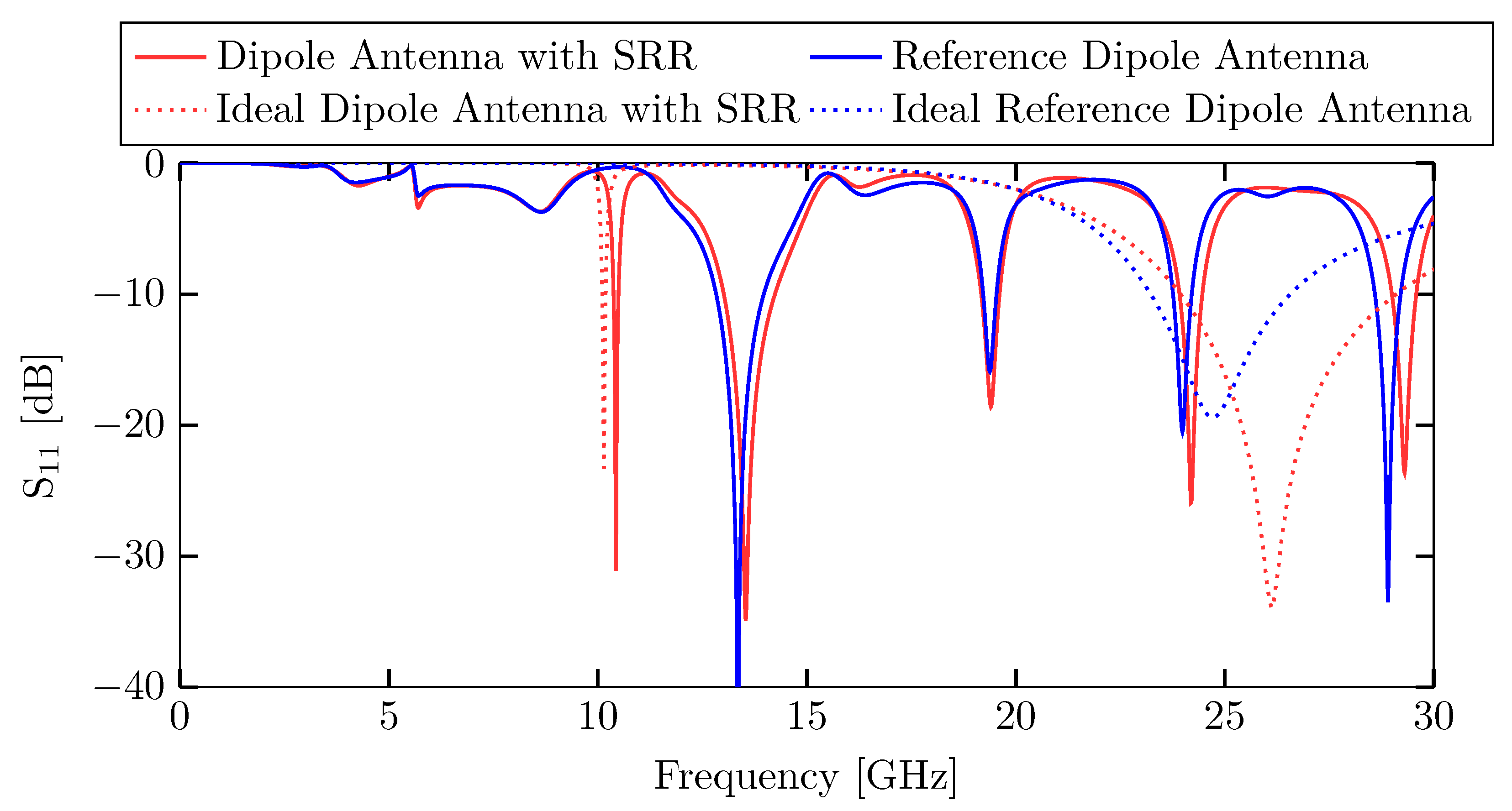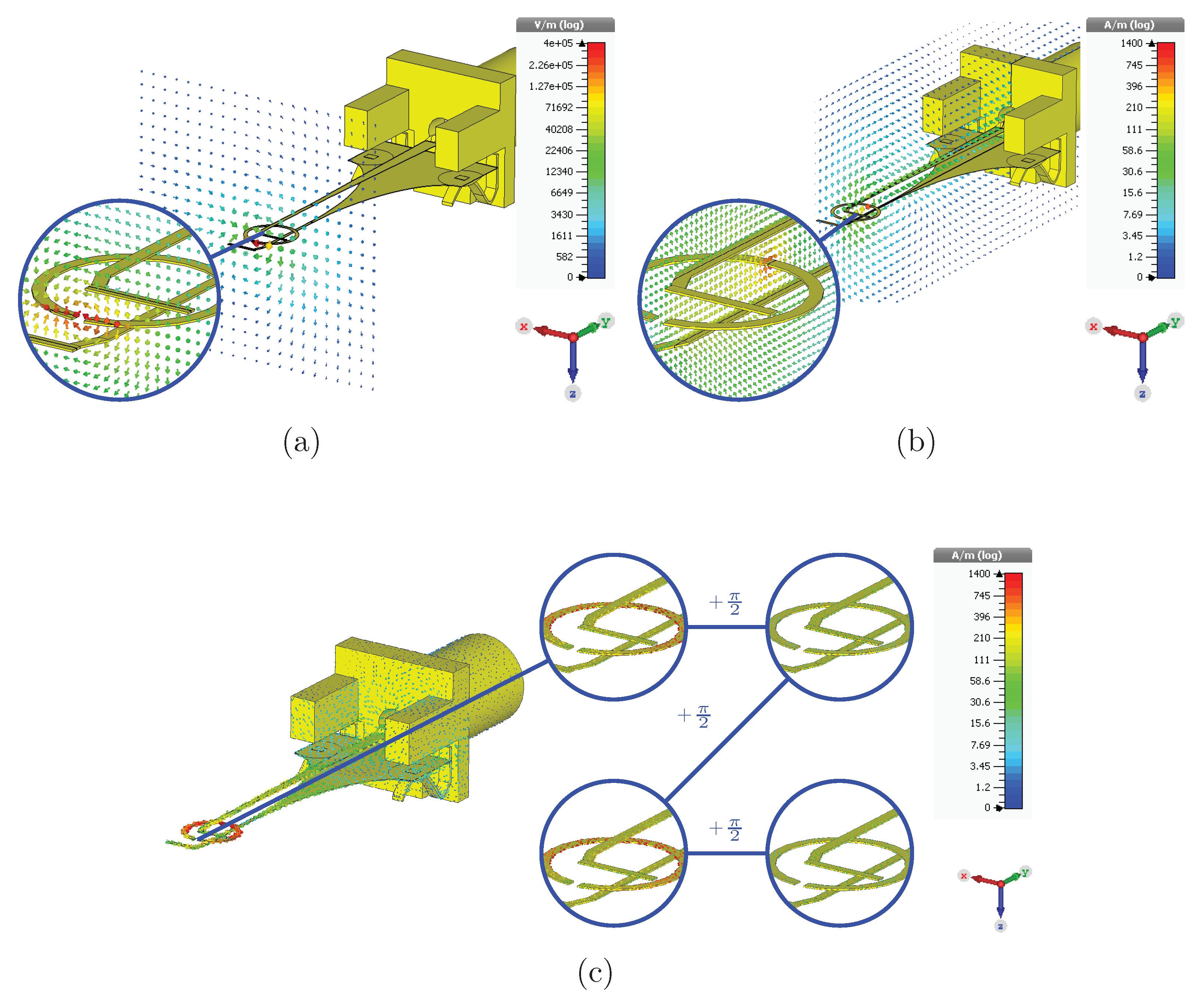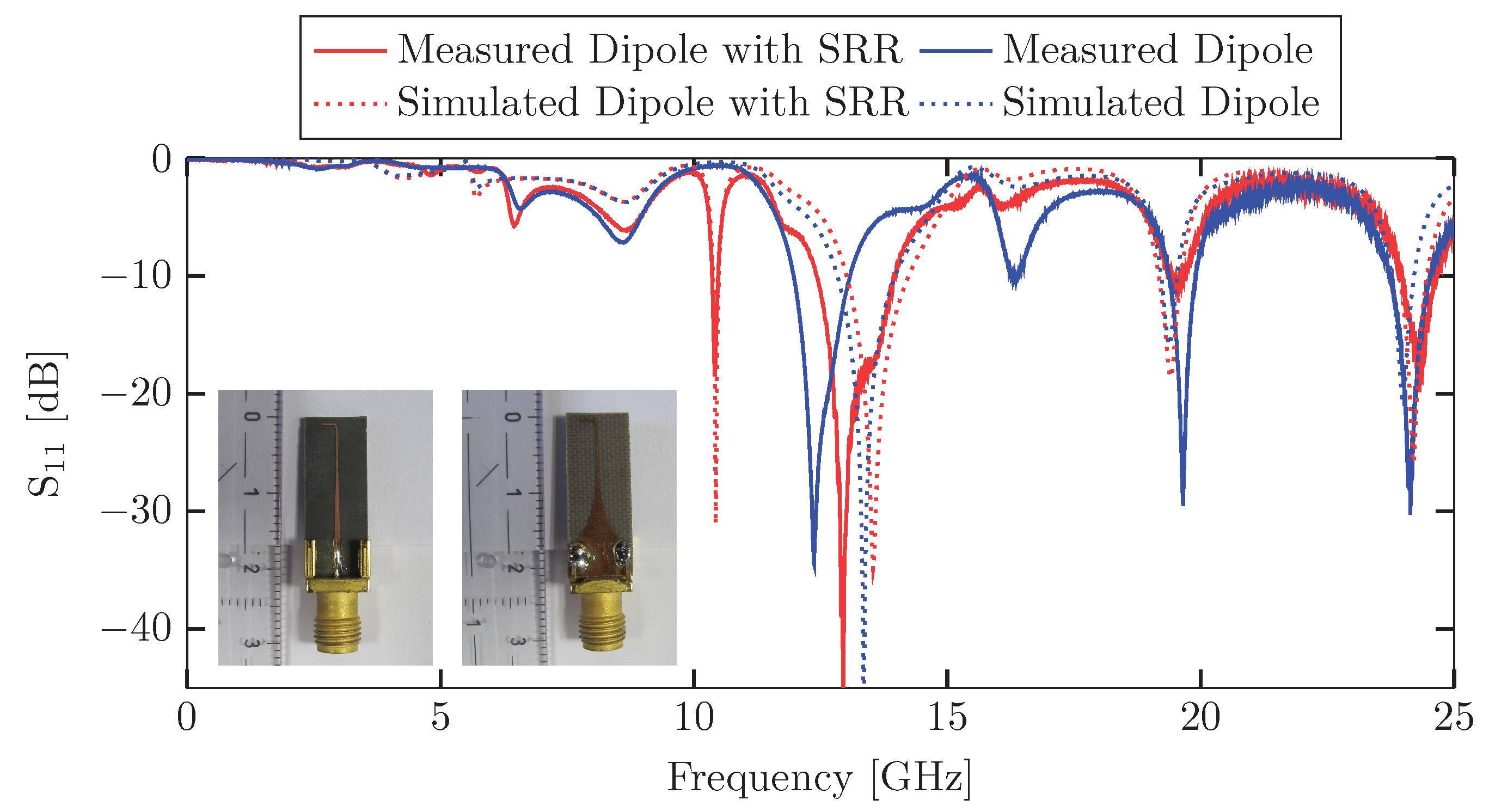2. Dipole Antenna with Split Ring Resonator
As described above, the presented antenna is a hybrid combination of a classic antenna and a subwavelength resonator. While the classic antenna itself has the typical electromagnetic size of about half a wavelength and is therefore designed to efficiently radiate waves at its antenna resonance frequency, its radiative properties dramatically change when the electric and magnetic field are near-field-coupled to a subwavelength resonator with differing resonance frequency. The hybrid structure of a classic antenna and a subwavelength oscillator can be excited with low insertion loss at the resonance frequency of the subwavelength element, although the classic antenna alone would not be excitable at this frequency. The subwavelength oscillator assumes the role of the radiating element and transmits electromagnetic waves at its own resonance frequency. This is confirmed by the observation that the hybrid structure always radiates at the resonance frequency of the subwavelength resonator, independent of the resonance frequency of the antenna. Interestingly, the hybrid structure is also efficient for large differences between the resonance frequencies of the classic antenna and subwavelength radiator, since the properties of the hybrid antenna are largely governed by the electric and magnetic near-field-coupling between classic antenna and subwavelength resonator.
In this context, we investigated the electromagnetic properties of the near-field-coupling between a dipole antenna and a subwavelength SRR. In this specific design, the resonance frequency of the dipole antenna at GHz was significantly larger than the resonance frequency of the SRR at GHz. In the combined structure, the dipole antenna serves as the feeding element and resonantly transfers energy to the bianisotropic SRR via both electric and magnetic near-field-coupling. After excitation, the SRR radiates electromagnetic waves into free space at its own resonance frequency. Our analysis of the surface currents also evidences that the SRR is the radiating element in the composite structure.
To investigate the spatial and spectral properties of the near-field-coupling between dipole antenna and SRR, we first numerically calculated the electromagnetic fields and the surface currents in the hybrid device. In order to obtain reliable simulation results, we exactly implemented the geometry of the hybrid antenna as fabricated for the experimental investigation, including the SMA connector and the feed line. For the full wave 3-D simulations we used CST Microwave Studio® 2018.
The geometric dimensions of the coupled dipole antenna and SRR structure are shown in
Figure 1. The hybrid structure is composed of three vertically stacked metal layers, where the SRR is located in the middle layer, the left dipole arm of the anthenna in the top layer and the right dipole arm in the bottom layer. This is schematically illustrated in
Figure 1a, where we left out the substrates and the SMA connector fot the sake of clarity. A more detailed description of the layers is shown in
Figure 1b,d. Starting from the top layer, the left dipole arm is placed on the top side of a RT/duroid
® 5880 substrate with the outer dimensions indicated in
Figure 1b. Below the duroid substrate, a second duroid substrate with itentical outer dimensions is placed, which contains the SRR on its top side serving as the middle layer, see
Figure 1c, and the right arm of the dipole antenna on its bottom side as the bottom layer, see
Figure 1d. The gap of the SRR is exactly aligned with the gap of the antipodal dipole to ensure maximal capacitive coupling between dipole antenna and SRR. The upper layer also contains the lightly tapered stripline to the left dipole arm, whereas the lower layer hosts the strongly tapered ground stripline to the right dipole arm. The detailed physical dimensions of the dipole arms and SRR are illustrated in
Figure 1e,f, respectively.
Figure 1g,h depict the bottom and the top side of the hybrid antenna including the SMA connector that was also taken into account in the numerical calculations. For the determination of the electric size of the radiating element of the hybrid antenna, which consists of the dipole and the SRR, we calculated the product between the magnitude of the wave vector
k of the radiated wave and the radius
a of the smallest possible sphere around the radiating part of the hybrid antenna. With a smallest sphere radius of
mm, we obtained
at a resonance frequency of
GHz. Therefore, we concluded that the radiating part of our hybrid antenna is electrically small, in compliance with the Chu-Wheeler criterion
.
To study the coupling from a microwave source to the hybrid antenna, we numerically calculated the dependence of the S
-amplitude on the microwave frequency. For reference, we also determined the S
-amplitude of the dipole antenna without the SRR. In all cases, the numerical calculation accounted for the feed lines and the SMA connector. The spectral dependence of the S
-amplitudes of the hybrid antenna and the dipole antenna without SRR are shown in
Figure 2 as blue and red solid line, respectively. For assessing the efficiency of the coupling from the microwave source to the antenna via the SMA connector and the feed lines, we also calculated S
-amplitudes of idealized versions of the hybrid antenna and the electric dipole antenna without SRR, when they were directly excited by a discrete port in the gap of the dipole antenna. In the idealized case, the SMA connector and the feed lines were not considered in the simulation model. The corresponding S
-amplitudes are plotted in
Figure 2 as blue and red dotted lines. The hybrid antenna exhibits several resonant spectral dips in the S
-amplitude, whose origins can be most readily identified by comparison with the idealized hybrid antenna without connector and feed line. A comparison shows that the spectral dip at
GHz displays the resonant oscillation of the SRR. The resonant dip at
GHz stems from the electric dipole antenna. This can be explained by comparison between the S
-amplitude of the hybrid antenna without SMA connector and feed line, and the S
-amplitude of the idealized dipole antenna without SRR, whose working frequency was designed for
GHz. From the S
-amplitude of the idealized hybrid antenna we can conclude that the resonance frequency of the dipole antenna increases to
GHz, when the SRR is added. This blue-shift is caused by capacitive and inductive coupling to the SRR. However, the resonance frequency decreases from
GHz to
GHz again, when the feed line and SMA connector are appended, which is obvious by comparison of the S
-amplitudes. The sharp dips at
GHz,
GHz and
GHz originate exclusively from the feed line and connector, yet do not impact the resonant behavior of the hybrid antenna at the working frequency of
GHz. The S
-amplitude of the hybrid antenna at the working frequency was
dB, which assures sufficient excitation.
In a next step, we investigated the electromagnetic near-field-coupling between the dipole antenna and the SRR. We observed that both electric and magnetic field coupling occurs between the two components and that the combined coupling explicitly determines the electromagnetic behavior of the hybrid device. In fact, its electromagnetic properties change completely, if one of the coupling mechanisms is missing. To study the electric coupling, we numerically calculated the spatial distribution of the electric field strength, which is plotted along the
x-
z cutting plane in
Figure 3a. For clarity, we did not depict the dielectric substrates in the electric field plots. Electric near-field-coupling occurs by capacitive coupling of the electric fields between the gap of the dipole antenna and the gap of the SRR. The electric field of the dipole antenna resonantly excites closed loop currents in the SRR by displacing the charges in the ring. The excited surface currents of the dipole antenna, and more specifically of the SRR, are illustrated in
Figure 3c. The zoomed insets show the surface currents on the SRR for advancing phase at steps of
. As can be seen, the surface currents build closed loops on the SRR and are significantly stronger on the SRR than on the dipole antenna. The oscillation strength of the SRR surface currents is maximal at the resonance frequency of
GHz, where most of the electromagnetic energy is transferred from the dipole antenna to the SRR. The magnetic field coupling is shown in
Figure 3b. The magnetic field penetrates the SRR and induces closed loop surface currents that are resonant at the same frequency as the surface currents excited by the electric coupling. We also elicited if either electric or magnetic coupling only would imply the same electromagnetic behavior of the hybrid antenna as observed for combined coupling. For pure magnetic coupling, we eliminated electric coupling by turning the split ring by
around the
z-axis, such that the electric field of the dipole antenna could no longer couple to the capacitive gap of the SRR. As a result, almost no energy was transferred from the dipole antenna to the SRR. Reversely, to limit the near-field-coupling to purely electric coupling, we turned the ring by
around the
y-axis, such that the magnetic field did not penetrate the SRR. Again, almost no energy was transferred from the dipole antenna to the SRR, which lets us conclude that the combined coupling is crucial to efficiently excite the SRR. Furthermore, it is notable that the S
-amplitudes of
Figure 2 indicate low reflection of the fed microwave at the hybrid antenna, which is a sign for strong resonant coupling exactly at the resonance frequency of the SRR at
GHz. As a result, most of the excitation energy is accepted by the antenna, which is also evidenced by the high magnitude of the surface currents in the SRR. To rule out high absorption in the metal and the dielectric of the antenna, we also numerically calculated the occurring losses as well as the radiation efficiency. Due to the resonant nature of the SRR, the calculated loss in the antenna amounts to 12%, while the overall calculated efficiency of
% is considerably high for an electrically small antenna. For this reason, we can expect that a fabricated hybrid antenna also radiates efficiently into free space.
For examination of the applicability of our findings, we fabricated both the electrically small hybrid antenna consisting of the dipole antenna and the SRR as well as a reference antenna composed of the same dipole antenna without SRR. We investigated both the coupling of a microwave source to the hybrid antenna, i.e., the S-amplitude, and the electric far-field spatial pattern of the electric field of the antenna. Furthermore, we compared these quantities to the corresponding numerical results.
Figure 4 shows the simulated and measured S
-amplitudes of the hybrid dipole antenna with SRR. For reference, we also simulated and measured the S
-amplitudes of a dipole antenna with the same physical dimensions as for the hybrid antenna, yet without SRR. The insets depict the hybrid dipole antenna with SRR from the front and back side.
The S-amplitude of the hybrid antenna displays several distinct spectral minima. First, we recognize a reflection minimum with an input return loss of dB at GHz, which corresponds to the resonance frequency of the SRR. We measured a dB coupling bandwidth of MHz at this frequency, which exactly matches the simulated value. Second, we identified a spectral minimum at GHz, which occurs exactly at the resonance frequency of the dipole antenna. Finally, we state that all other spectral minima between GHz and GHz stem from the stripline and the SMA connector, however do not impact the performance of the hybrid antenna at the working frequency of GHz.
To study the radiative properties, we numerically calculated and experimentally measured the spatial angular distribution of the electric far field of the hybrid antenna, which is shown in
Figure 5 at the resonance frequency
GHz. It should be noted that we could only measure the electric far-field of the antenna in forward direction, which corresponds to the right hemisphere in the polar diagrams and angles between
and
in both the E-plane and the H-plane. This restriction was imposed by our specific experimental set-up and is not a limitation of the antenna itself. As it can be seen in
Figure 5b, we also measured the electric field in the H-plane for angles between
and
by rotating the antenna under test by
around the normal to the H-plane. By this means, we were able to record a second set of electric far-field data in the agular range between
and
.
Figure 5a displays the electric far-field distribution in the E-plane, while
Figure 5b depicts the distribution in the H-plane. The relative orientation of the hybrid antenna to the defined planes is illustrated in the insets of the polar diagrams. In order to compare the numerically calculated E-field amplitudes with the measured quantities, we normalized the amplitudes to
dB. The radial lines in the diagrams mark the
dB angular width of the main lobe of the radiation pattern. We observed the main lobe direction of the antenna at
with a
dB angular width of
in the E-plane, in good agreement with the numerical calculations. In the H-plane, the main lobe is directed at
with a
dB angular width of
, also in good agreement with the numerical values. The reason for the deviation of the main lobe direction from the
axis in the E-plane and H-plane is caused by the asymmetry of the feed line. This argument is corroborated by a comparison with the radiative far-field of an idealized dipole antenna with SRR that lacks the SMA connector and the feed line. Such an idealized antenna shows perfect symmetry of the far-field radiation pattern around the
axis, when it is excited in the gap of the electric dipole by a discrete excitation port.
To judge the performance of our electrically small hybrid antenna, we compared characteristic quantities such as resonance frequency,
dB bandwidth, fractional bandwidth, electrical size
and efficiency to the specifications of other electrically small antennas that were recently reported. This comparison is summarized in
Table 1. With an electrical size
, an efficiency of 87.9% and a fractional bandwidth of 1.2% the antenna is comparable in its performance to other designs. The reason for the bandwidth limitation lies in the narrow-band nature of the electric dipole antenna and the sharp resonance of the SRR.









